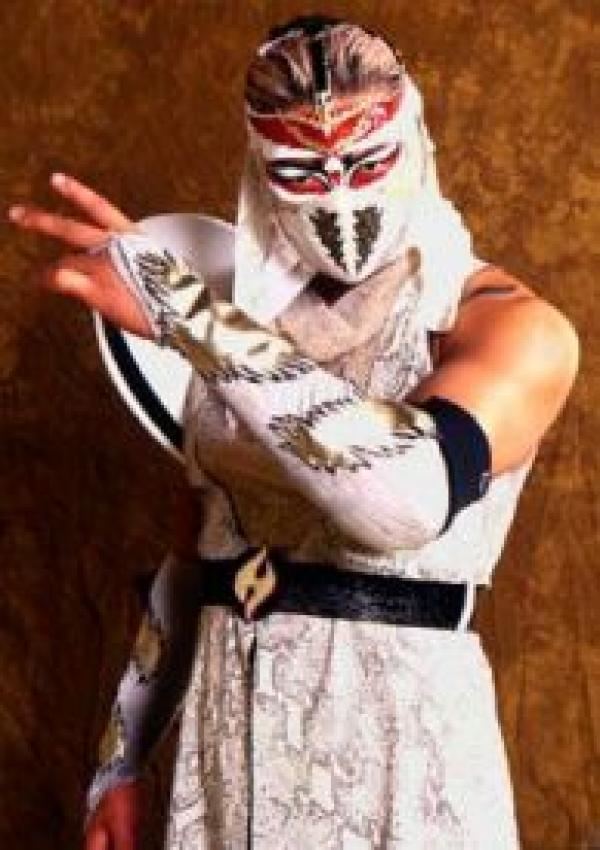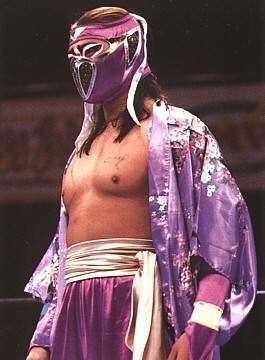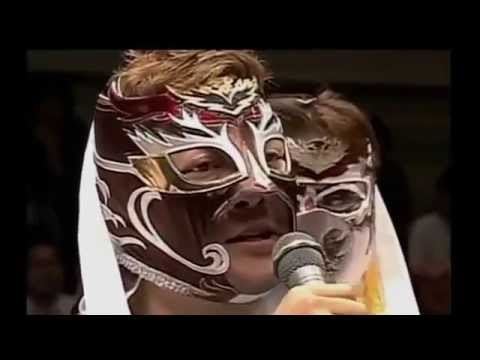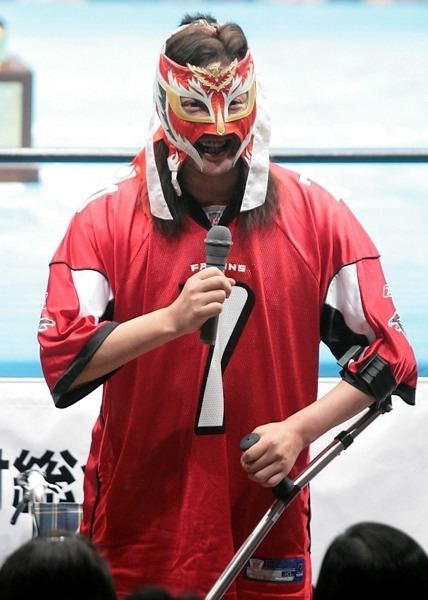Billed height 1.83 m (6 ft 0 in) Debut May 5, 1991 Billed weight 75 kg (165 lb) Retired October 22, 2001 | Name Eiji Ezaki Role Professional wrestler | |
 | ||
Born November 29, 1968Yatsushiro, Kumamoto, Japan ( 1968-11-29 ) Ring name(s) HayabusaHDarkside of HayabusaEiji Ezaki Similar People Atsushi Onita, Terry Funk, みのや雅彦 | ||
Eiji Ezaki (江崎 英治, Ezaki Eiji, 29 November 1968 – 3 March 2016) was a Japanese professional wrestler, better known as the masked Hayabusa (ハヤブサ, Hayabusa, "Falcon"), who worked primarily for Atsushi Onita's Frontier Martial Arts Wrestling (FMW) promotion.
Contents
- Rip hayabusa the greatest wrestler who ever lived
- Early years 19871991
- Frontier Martial Arts Wrestling 19911993
- North American excursion 19931995
- Return to FMW 19952001
- Post retirement
- Other media
- Personal life
- Death
- In wrestling
- Championships and accomplishments
- References

Rip hayabusa the greatest wrestler who ever lived
Early years (1987–1991)

Trained by former All Japan Pro Wrestling star and sumo wrestler Takashi Ishikawa, Eiji Ezaki made his professional wrestling debut at an independent show on November 2, 1987, teaming with Masashi Honda against three upper classmen. He and Honda would struggle in the very small indy circuit for four years before joining Frontier Martial Arts Wrestling's dojo, headed by another former AJPW alumnus Tarzan Goto.
Frontier Martial-Arts Wrestling (1991–1993)

Ezaki made his FMW debut on May 5, 1991, where he teamed up with Amigo Ultra to defeat Akihito Ichihara and Yukihide Ueno. As is customary in professional wrestling, especially puroresu, Ezaki lost the majority of his matches for the early years of his career. In September 1993, Atsushi Onita sent Ezaki overseas to Mexico.
North American excursion (1993–1995)
Ezaki adopted the Hayabusa gimmick in December 1993 while in Mexico. While there, he learned the lucha libre style from wrestling instructor Rey Misterio, Sr. Ezaki wrestled for the World Wrestling Association, AAA, and Consejo Mundial de Lucha Libre during his time in Mexico. He then returned to Japan to face Jushin Thunder Liger in a well received first round match during the Super J-Cup tournament. During his time in Mexico, Victor Quinones would offer Ezaki a contract to defect to IWA Japan, but declined, showing loyalty to FMW. He would also learn the art of high-flying moves from Ultimo Dragon. He would remain in Mexico until December 1994.

Between January 1995 and April 1995, Ezaki wrestled in the United States, mainly in the Florida area. During this time, the World Wrestling Federation was interested in Ezaki and offered a tryout, but he declined and remained with FMW.
Return to FMW (1995–2001)

Upon his return to FMW in May 1995, Hayabusa wrestled very dangerous matches involving barbed wire and explosives. After one "Exploding Cage" match, he was rushed to the hospital due to severe burns. Hayabusa's rivals included Mr. Gannosuke, The Gladiator, and Onita himself, and he frequently teamed with Jinsei Shinzaki. Ezaki occasionally altered his character to the "Darkside of Hayabusa" or the maskless "H."

Ezaki wrestled one match in Extreme Championship Wrestling at Heatwave in 1998. He and Jinsei Shinzaki unsuccessfully challenged Rob Van Dam and Sabu for the promotion's World Tag Team Championship.
In October 2001, Ezaki suffered a career-ending injury during a match against Mammoth Sasaki. Ezaki attempted a springboard moonsault off the middle rope and lost footing, landing on his head, cracking two of his vertebrae and leaving him paralyzed. The injury provoked a high fever and required surgery. Ezaki was considered the heart and soul of FMW, and after his departure, the company slowly folded.
Post-retirement
Ezaki later pursued a career as a singer. He promoted a new wrestling company called WMF (Wrestlings Marvelous Future) that contained up-and-coming wrestlers. The name was chosen since, spelled backwards, the initials are FMW in honor of the late company. He traveled to a few WWE events where he met old friends such as Sabu, Rob Van Dam, and Rey Mysterio backstage. He also took photographs with Vince McMahon, Shane McMahon, and Triple H, and spoke with Jeff Hardy.
Ezaki attended the PWU (Pro Wrestling Unplugged) FAHRENHEIT: 3RD DEGREE event on August 19, 2006 at the New Alhambra (formerly known as ECW Arena). This was his first appearance in the USA since 2000, the last time being at E3 in Los Angeles, helping promote TOKYOPOP's FMW DVDs by having a 6-man tag match. He also participated in a shoot interview with RF Video.
Ezaki was active in working with the Dragon Gate promotion. He recorded a debut album with Dragon Kid titled Trust! which came out in November 2007. He partook in the company's first US tour, joining them in their appearance in Los Angeles on September 5 and Hawaii on September 8, 2008. Ezaki also designed the tour's T-shirt. When asked about his career in an interview, Ezaki said that one never knows what the chances are of a return to the ring.
On 3 April 2015, Hayabusa was part of a press conference announcing the return of FMW. He served as the executive producer of the promotion.
Other media
Personal life
Ezaki was the oldest of two sons. His grandparents on his mother's side of the family were owners of a hotel, before his parents took over.
Ezaki married his wife Harumi on April 7, 1997. Together, they had two daughters, Ayane (born October 19, 1997) and Shie (born May 10, 1999). He and Harumi amicably divorced in 2004, but remained friends, while sharing custody of their daughters.
Ezaki was close friends with Jushin Thunder Liger since 1994. The two had a falling out in 1996 after Ezaki turned down a deal with NJPW, but they mended their friendship in 2005.
In May 2005, he performed a play called The Shinichi Amano Story at the Tokyo Shinjuku Theater. He portrayed the main character's best friend Fuyuki Hayato, an injured air pilot soldier in World War II, who is wheelchair-bound. His performance was given positive reviews and the play was a huge success.
On April 25, 2010, his father died.
By 2015, Ezaki had regained the use of his legs and could stand on his own and walk with a cane.
Death
Ezaki died of a subarachnoid hemorrhage on 3 March 2016, at age 47. He was found dead at his home. The owner of a nearby tavern, whom he was supposed to meet about an upcoming concert on March 7, went to his home when he did not arrive for the meeting, and there found his body.
